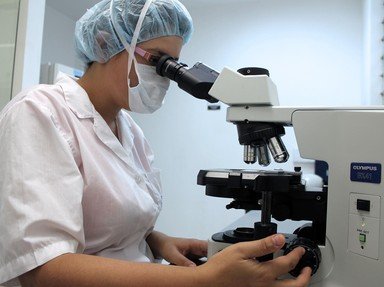Quiz Answer Key and Fun Facts
1. Basically, there are two major participants in every cell communication activity: the "doer" of the communication, and the "receiver" of the communication. They may also communicate through direct and indirect contact, also called local and long-distance signaling, respectively. Which of the following is an example of long-distance signaling occurring in the body?
2. The receiving end of a cellular conversation can be dissected into three stages. These stages were elucidated by Earl Sutherland, whose research led to a Nobel Prize in 1971. He and his colleagues were investigating how an animal hormone that stimulates the breakdown of the storage polysaccharide glycogen within liver cells and skeletal muscles, which in turn releases the sugar glucose-1-phosphate, which the cell converts to glucose-6-phosphate.
The question is, what was the animal hormone?
3. The three stages of "cellular conversation" are reception, transduction, and response. In which of these stages are signal molecules binding to certain proteins in the cell membrane, causing the protein to change shape?
4. Most water-soluble signal molecules bind to specific sites on receptor proteins embedded in the cell's plasma membrane. Such a receptor transmits information from the extracellular environment to the inside of the cell by changing shape or aggregating when a specific ligand, or the molecule that specifically binds to another molecule, binds to it. There are three major types of such membrane receptors. Which of the following membrane receptors is not one of them?
5. In the second stage, transduction, cascades of molecular interactions relay signals from receptors to target molecules in the cell. The binding of a specific signal molecule to a receptor in the plasma membrane triggers the first step in the chain of molecular interactions that leads to a particular response within the cell. What are these interactions?
6. Many signaling pathways involve small, nonprotein, water-soluble molecules or ions called messengers. One such messenger, which transmits signals from the plasma membrane to the metabolic machinery of the cytoplasm, is found by Earl Sutherland in his research. What are these messengers?
7. Our understanding of signaling pathways involving messengers has allowed us to develop treatments for certain conditions in humans. One such "technology" is the compound/are the compounds that inhibits/inhibit the hydrolysis of a messenger to another. What is this compound/ these compounds that prolong/prolongs such signal and was originally prescribed for chest pains?
8. What is a protein kinase, and what is its role in routes of transduction of chemical signals?
9. The third and last stage is response, where cell signaling leads to regulation of cytoplasmic activities or transcription. Also, scaffolding proteins are large relay proteins increase the efficiency of signal transduction in many cases. How can two cells with different scaffolding proteins behave differently in response to the same signaling molecule?
10. Here's a trivia question for you, to top it all off. Research has discovered that cells of this organism identify their mates by chemical signaling. They have two mating types, called a and α (alpha). This organism is also used for making wine, bread, and beer. What is the scientific name of this organism?
Source: Author
memoria090893
This quiz was reviewed by FunTrivia editor
crisw before going online.
Any errors found in FunTrivia content are routinely corrected through our feedback system.
